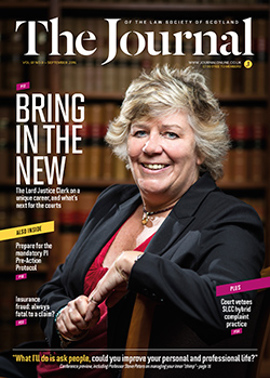The future, step by step

In last month’s Journal we covered two initiatives – application programme interfaces and digital signatures – that will bring real benefits to our customers. We also reiterated the incremental approach we are taking to building, launching and improving these digital solutions in response to customer feedback gathered at every stage.
This approach to our digital transformation is also being used for existing products. Still relatively new are advance notices, brought in at the request of conveyancers as part of the 2012 Act, to replace letters of obligation and to satisfy insurers.
This product was very popular from launch in late 2014, but from the collating of user feedback, which was gathered by our customer services teams and specific user feedback sessions, the need for the addition of a save-and-share function was clear.
In addition to adding this in 2015, with 50% of all advance notices using it, we also made it possible to save the documents as PDFs so that they could be downloaded and checked/shared in the format they are submitted – a useful tool on our application form, too.
Other feedback has seen improvements to shared and sharing plot information on Registers Direct, on accessing large plans, and revising the timescale an application can be held in draft form from 50 to 120 days.
Systems that stand up
We have also changed our notifications to add information useful to those dealing with large volumes of applications, and improved our monitoring system to give us earlier warning if things aren’t going smoothly – an increasingly rare occurrence.
It is the work behind the scenes that has probably made the most impact of all. Our systems are now more robust and changes can be made with far less inconvenience to our customers. What’s more, periods of system downtime are nearly at nil.
We could not make these improvements without the participation of our stakeholders through a number of feedback channels, but specifically through participation in our user experience panel. If you would like to suggest improvements and/or be involved in the development of future online tools, please get in touch. The evidence is clear that it will be time well spent.
Digital signatures: an update
Last month we introduced a pilot, in conjunction with the Law Society of Scotland, looking at applying digital signatures within ARTL using the Society's smartcard. We have now tested and proved that the smartcard works with the ARTL system. The next stage of the pilot is to continue engagement with the Society and those individual firms that wish to start using the smartcard in live ARTL applications.
In this issue
- Beyond the named person service
- Sexual harassment: an everyday problem
- Governing Scotland in a federal United Kingdom
- Losing our judgment? (1)
- Reading for pleasure
- Opinion: Alison Reid
- Book reviews
- Profile
- President's column
- The future, step by step
- People on the move
- Changing face of the courts
- Success: the chimp factor
- Courts reform: a call to pre-action
- Teeth that could be sharper
- Good claims, bad lies
- Unlocking doors: demystifying squatting
- Back to basics
- Brexit and IP: what should solicitors be doing now?
- Agency, insolvency and termination
- Brexit and the agricultural sector
- A carnival for some, but not for others
- Scottish Solicitors' Discipline Tribunal
- Culling of the hybrids
- Common property: what policy?
- Cause of action
- Client balances: reminder issued
- Law reform roundup
- From the Brussels office
- Paralegal pointers
- Your Law Society of Scotland Council Members
- At the doors of the court
- Ask Ash
- To the focused, the medals
- Losing our judgment?
- MacKenzie boosts Society's AML drive






